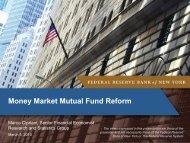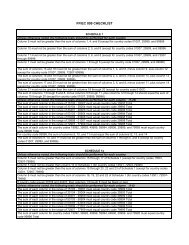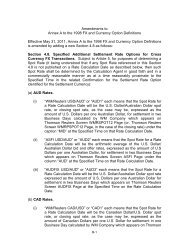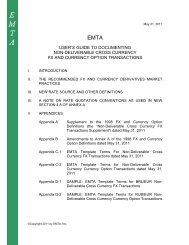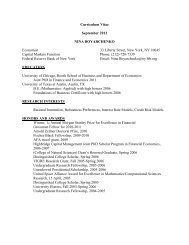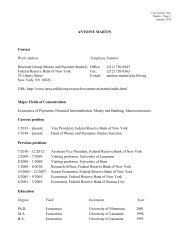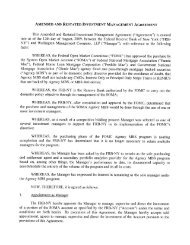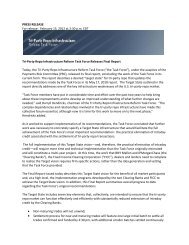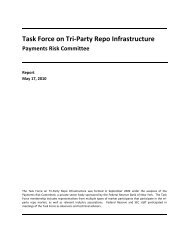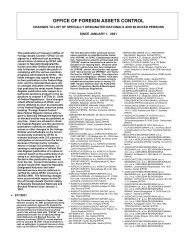Residential Foreclosures in the City of Buffalo, 1990-2000 - Federal ...
Residential Foreclosures in the City of Buffalo, 1990-2000 - Federal ...
Residential Foreclosures in the City of Buffalo, 1990-2000 - Federal ...
Create successful ePaper yourself
Turn your PDF publications into a flip-book with our unique Google optimized e-Paper software.
Table 13 also demonstrates a socioeconomic component <strong>of</strong> subprime foreclosures.<br />
The three communities <strong>in</strong> which subprime foreclosures were most prevalent were<br />
predom<strong>in</strong>ately m<strong>in</strong>ority and low <strong>in</strong>come. This f<strong>in</strong>d<strong>in</strong>g is consistent with research<br />
reveal<strong>in</strong>g that subprime lend<strong>in</strong>g is more common among m<strong>in</strong>orities. 12 However, <strong>in</strong> our<br />
study, <strong>the</strong> highest <strong>in</strong>come m<strong>in</strong>ority community— North East— showed <strong>the</strong> lowest rate <strong>of</strong><br />
subprime foreclosure overall. The only lower <strong>in</strong>come m<strong>in</strong>ority community with a<br />
substantial Hispanic population— West Side-Central--had a relatively low rate as well.<br />
Moreover, South <strong>Buffalo</strong>-River— a higher <strong>in</strong>come white community— had a relatively<br />
high percentage <strong>of</strong> foreclosures on ref<strong>in</strong>ance loans made by subprime lenders, while<br />
Riverside— a low-<strong>in</strong>come white community— had a small share <strong>of</strong> subprime<br />
foreclosures. Thus, <strong>the</strong> association between subprime foreclosure and <strong>the</strong> socioeconomic<br />
characteristics <strong>of</strong> <strong>Buffalo</strong>’s communities is not clear cut.<br />
F<strong>in</strong>ally, <strong>the</strong>re appears to be little relationship between overall foreclosure rates<br />
and subprime foreclosures, as <strong>the</strong> two communities with high foreclosure rates did not<br />
show high shares <strong>of</strong> foreclosures on subprime loans. As noted, subprime foreclosures<br />
were least prevalent <strong>in</strong> <strong>the</strong> North East community and were only slightly above average<br />
<strong>in</strong> East Delavan.<br />
Interest Rate Proxy for Subprime Lend<strong>in</strong>g<br />
We now exam<strong>in</strong>e <strong>the</strong> effect <strong>of</strong> subprime lend<strong>in</strong>g on foreclosures by look<strong>in</strong>g at <strong>the</strong> <strong>in</strong>terest<br />
rates on foreclosed loans. Although subprime loans may have several features that<br />
dist<strong>in</strong>guish <strong>the</strong>m from prime loans, <strong>the</strong> most important difference is <strong>the</strong>ir higher <strong>in</strong>terest<br />
rates. Research suggests that <strong>the</strong> added risk <strong>in</strong>herent <strong>in</strong> subprime loans justifies <strong>the</strong><br />
charg<strong>in</strong>g <strong>of</strong> an additional 1.5 percent to 4 percent by lenders for provid<strong>in</strong>g credit. 13 Us<strong>in</strong>g<br />
this standard, we calculate <strong>the</strong> number <strong>of</strong> percentage po<strong>in</strong>ts by which <strong>the</strong> <strong>in</strong>terest rate<br />
exceeded <strong>the</strong> average <strong>in</strong>terest rate at <strong>the</strong> time <strong>of</strong> <strong>the</strong> loan. 14 We divide foreclosures <strong>in</strong><br />
<strong>2000</strong> <strong>in</strong>to three categories based on this difference: very high cost (greater than 4<br />
percent), high cost (2 percent to 4 percent), and average cost (less than 2 percent).<br />
12 Even when controll<strong>in</strong>g for such factors as <strong>in</strong>come and credit history, studies consistently f<strong>in</strong>d that black<br />
borrowers have a higher probability <strong>of</strong> us<strong>in</strong>g <strong>the</strong> subprime market. See, for example, Nichols, Penn<strong>in</strong>gton-<br />
Cross, and Yezer, <strong>2000</strong>.<br />
13 Goldste<strong>in</strong>, 1999, p. 9.<br />
48



